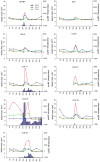Genetics of host response to Leishmania tropica in mice - different control of skin pathology, chemokine reaction, and invasion into spleen and liver
- PMID: 22679519
- PMCID: PMC3367980
- DOI: 10.1371/journal.pntd.0001667
Genetics of host response to Leishmania tropica in mice - different control of skin pathology, chemokine reaction, and invasion into spleen and liver
Abstract
Background: Leishmaniasis is a disease caused by protozoan parasites of genus Leishmania. The frequent involvement of Leishmania tropica in human leishmaniasis has been recognized only recently. Similarly as L. major, L. tropica causes cutaneous leishmaniasis in humans, but can also visceralize and cause systemic illness. The relationship between the host genotype and disease manifestations is poorly understood because there were no suitable animal models.
Methods: We studied susceptibility to L. tropica, using BALB/c-c-STS/A (CcS/Dem) recombinant congenic (RC) strains, which differ greatly in susceptibility to L. major. Mice were infected with L. tropica and skin lesions, cytokine and chemokine levels in serum, and parasite numbers in organs were measured.
Principal findings: Females of BALB/c and several RC strains developed skin lesions. In some strains parasites visceralized and were detected in spleen and liver. Importantly, the strain distribution pattern of symptoms caused by L. tropica was different from that observed after L. major infection. Moreover, sex differently influenced infection with L. tropica and L. major. L. major-infected males exhibited either higher or similar skin pathology as females, whereas L. tropica-infected females were more susceptible than males. The majority of L. tropica-infected strains exhibited increased levels of chemokines CCL2, CCL3 and CCL5. CcS-16 females, which developed the largest lesions, exhibited a unique systemic chemokine reaction, characterized by additional transient early peaks of CCL3 and CCL5, which were not present in CcS-16 males nor in any other strain.
Conclusion: Comparison of L. tropica and L. major infections indicates that the strain patterns of response are species-specific, with different sex effects and largely different host susceptibility genes.
Conflict of interest statement
The authors have declared that no competing interests exist.
Figures







References
-
- Rittig MG, Bogdan C. Leishmania-host-cell interaction: complexities and alternative views. Parasitol Today. 2000;16:292–297. - PubMed
-
- Reiner SL, Locksley RM. The regulation of immunity to Leishmania major. Annu Rev Immunol. 1995;13:151–177. - PubMed
-
- McMahon-Pratt D, Alexander J. Does the Leishmania major paradigm of pathogenesis and protection hold for New World cutaneous leishmaniases or the visceral disease? Immunol Rev. 2004;201:206–224. - PubMed
-
- Farrell JP. Leishmania. Boston, Dordrecht, London: Kluwer Academic Publishers; 2002. 193
-
- Kobets T, Grekov I, Lipoldová M. Leishmaniasis: prevention, parasite detection and treatment. Curr Med Chem. 2012;19:1443–1474. - PubMed
Publication types
MeSH terms
Substances
LinkOut - more resources
Full Text Sources

